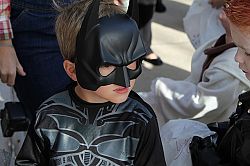

Now that spooky season is upon us it is important to be mindful of the dangers that can lurk around any nearby corner. Unfortunately, it seems the dangers have evolved from ghosts and ghouls to the resultant waste left behind by one-time costumes and throwaway outfits.
Research has suggested there are to be an estimated 2,000 tonnes of plastic waste that will be generated from the clothing sold in the leading retailers this year - this is equivalent to 83 million plastic bottles. An environmental charity, Hubbub, has set about an investigation to look into the seasonal outfits and has found that 83% of the material used was of pollution oil-based plastics that are likely to just end up in a landfill following the end of the holiday. Among the 324 separate textile items that were identified, the most common plastic polymer found was polyester. It accounted for 69% of all materials, whereas cotton only accounted for 10%.
In order to urge consumers to start choosing more environmentally friendly options - Hubbub has teamed up with the Fairyland Trust. An employee of Fairyland Trust, Chris Rose, has said, "The scariest thing about Halloween now is plastic. More costumes are being bought each year as the number of people participating in Halloween increases. Consumers can take action to avoid buying new plastic and still dress up for Halloween by buying from charity shops, or re-using costumes, or making their own from non-plastic materials."
On top of this, there are calls for both manufacturers and retailers to rethink their product ranges for the season. As well as with costumes, consumers are further tempted with various extra plastic-based accessories, including (but not limited to) synthetic wigs, hats, masks, buckets, party decorations, glittery makeup and even costumes for your pets. Further insight has shown near to 30 million people throughout the UK dress up for Halloween, with a staggering 90% of families considering buying their costumes. Only a tiny portion of these costumes that are bought are recycled, whilst 7 million are thrown to the dump.
One of the issues could stem from the labelling applied to such clothing, many consumers simply do not realise what they are buying is a polymer material - if the labelling on clothing was better and more consistent, this could maybe be avoided.
A recent study in 2017 had found that less than 1% of the material that was used to produce clothing was being recycled into new clothes. Commenting on the issue, Trewin Restorick (the chief executive of Hubbub) has said, "These findings are horrifying. However, the total plastic waste footprint of Halloween will be even higher once you take into account other Halloween plastics such as party kits and decorations, much of which are also plastic, or food packaging."
The plastics in costumes are not chosen for their sustainability, they are in fact chosen for their usefulness in child safety - something retailers take very seriously, and will likely hold at the forefront of their design plans.
A spokesperson for M&M has said, "All M&M kidswear is designed to be hand-me-down quality, including fancy dress costumes which can be reworn, passed on to friends and family or 'shwopped' through our partnership with Oxfam."
Tesco has said, "We've removed more than 4,000 tonnes of plastic from 8,000 products so far, and have made clear that there is no place for materials that are not recyclable. In our Halloween range, we have moved to alternative materials wherever possible, such as fabric trick or treat buckets and sustainably sourced paper-based tableware.